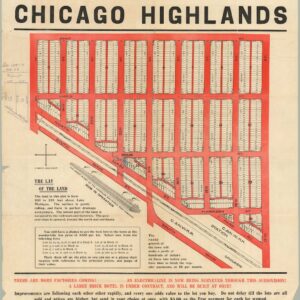A first edition presentation copy inscribed by the author — Frederic M. Thrasher’s study and map of Gangs in Prohibition-Era Chicago.
Chicago’s Gangland. Prepared by Frederic M. Thrasher 1923-26
Out of stock
Description
What makes this example unlike any other?
This is an intact, first edition, signed presentation copy of Frederic M. Thrasher’s book from 1927: The Gang: A Study of 1,313 Gangs in Chicago, complete with his famous map of gangs and ganglands in 1920s Chicago. The volume itself is in the original publisher’s tan buckram, with orange title labels printed in black on the upper cover and spine. It comes in its original unclipped dust jacket. In addition to being signed by the author, the book has also been inscribed: “To my dear friend, Rusty Robbins. Sincerely, Frederick M. Thrasher”.
The gangland map
Thrasher’s The Gang was a seminal sociological study of gangs and crime syndicates in 1920s Chicago. It was issued with a large thematic map of the city, printed as an offset lithograph in red, gray, and black ink. Originally part of Thrasher’s doctoral dissertation, the map came to visualize just how deeply engrained and surprisingly structured crime was in Chicago. It has become as iconic as the study itself, causing it often to be missing from copies of the book that appear on the open market.
Among the many reasons that Thrasher’s map has won such wide recognition and enjoys such popularity among collectors is the fact that it documents the distribution of gang activities during the Roaring 1920s. While most people today associate this era with the Mob and characters like Al Capone, Thrasher was more concerned with gang formations among second-generation immigrant children.
“Isolation is common to almost every vocational, religious or cultural group of a large city. Each develops its own sentiments, attitudes, codes, even its own words, which are at best only partially intelligible to others.”
A central tenet in Thrasher’s study was that urban environments are highly conducive, if not conditional, to gang-related crime, and he applied thematic mapping in order to underline this point emphatically. While the use of thematic mapping was not new in the social sciences (Florence Kelley had used a similar method to document living conditions in Chicago in the 1890s), it had never been applied to studies of crime or criminal syndicates before. Thrasher used his thematic map to demonstrate the existence of a physical urban zone that he termed Gangland:
“… the gang occupies what is often called “the poverty belt”— a region characterized by deteriorating neighborhoods, shifting populations, and the mobility and disorganization of the slum. Abandoned by those seeking homes in the better residential districts, encroached upon by business and industry, this zone is a distinctly interstitial phase of the city’s growth.”
The identification of this geographically and socially interstitial area of the city from which gang-related crime drew its oxygen was the most important conclusion in Thrasher’s study and ultimately the reason that he felt it necessary to illustrate his thesis with a thematic map. While Thrasher does consider the social ostracism of certain immigrant communities as a factor in his study, he also maintains the notion that second-generation immigrant children are especially at risk of evolving from “play groups” into proper youth gangs, with all the criminality, cost, and danger that this entails.
“An immigrant colony…is itself an isolated social world…the gang boy moves only in his own universe and other regions are clothed in nebulous mystery…he knows little of the outside world.”
In this sense, and despite its standing as a milestone in the sociological literature regarding organized crime in urban areas, Thrasher’s study comes off as somewhat antiquated and biased by today’s standards. His map, however, still commands great fascination and does an excellent job of supporting his theories. It is a chart extremely rich in detail, well worth studying carefully, but as one draws back from the map, the urban interstices that Thrasher proposes as Gangland really do stand out quite clearly.
The map depicts the city from Lake Shore West to Austin Avenue, and from 95th Street in the south to Bryn Mawr Avenue in the north. It includes numerous annotations printed in red, black, and gray. Less ominous sounding labels such as “Parks, Boulevard and Cemeteries”, “Industrial Property”, and “Railroad Property” are indicated by different shadings in gray, whereas areas associated with crime or gangs are marked in different shades of red. Gang turfs are subdivided into ‘Gangs with clubrooms’ and those without, shown using red triangles and red circles respectively. The annotations in red also identify some of the potential ‘incubators’ of crime that Thrasher proposed. Many of these carry evocative names such as Gang Camp (Auto Thieves) or RR Depredations. Other examples include Hobohemian Drug Gangs in Gold Coast, The Jewish-Polish Frontier in Douglas Park, and Slave Town in what is now Randolph Street Market. The map also demarcates ethnic groupings such as German, Black, Jewish, although such labels are in the more neutral gray nuances.
Cartographer(s):
Fredric Milton Thrasher was a sociologist at The University of Chicago and one of the most prominent members of the Chicago School of Sociology in the 1920s. He was born in Shelbyville, Indiana in 1892 and graduated from DePauw University in 1916 with a degree in social psychology. Among his most famous academic works is The Gang: A Study of 1,313 Gangs in Chicago, which essentially was the publication of his doctoral thesis. In the 1930s he moved to New York, where he took over a chair in Social psychology at New York University until his retirement in 1959. Towards the end of his career, he conducted several studies of the potential negative impact of comic books on youth delinquents.
Condition Description
Map in excellent condition, backed and flattened. Dust jacket of book worn (spine panel chipped with tears, extremities rubbed with light dust soiling).


![[Vietnamese Maps of North America: Mexico, Canada, USA]](https://neatlinemaps.com/wp-content/uploads/2022/04/NL-01262-USA_thumbnail-scaled-300x300.jpg)
